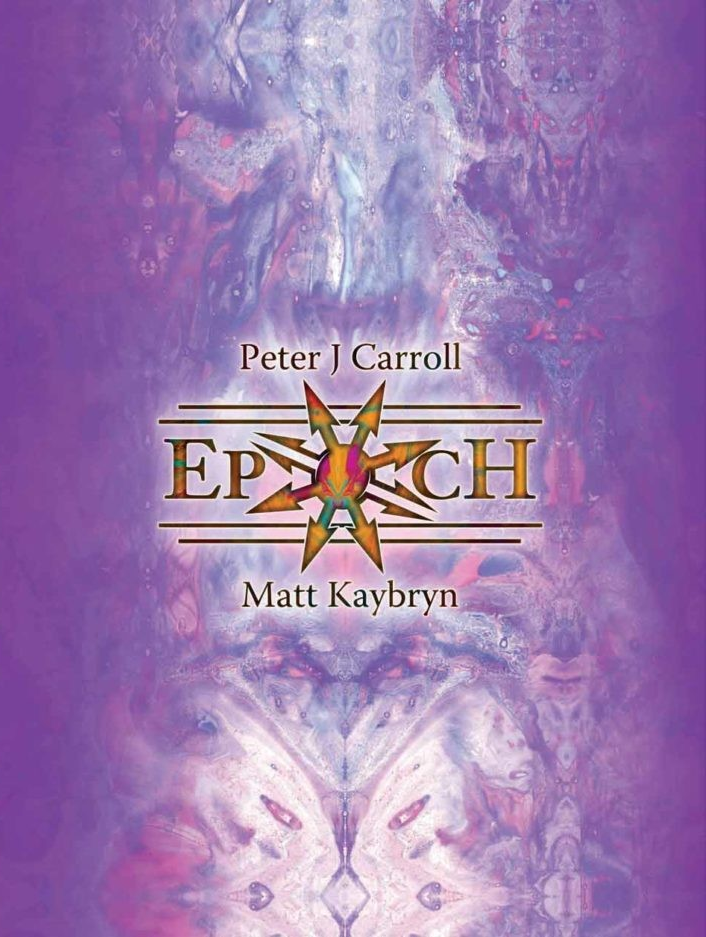
The Epoch – Hardbound Book (New Edition)
Plus Portals of Chaos Deck
By Peter Carroll and Matt Kaybryn


The Epoch – Hardbound Book (New Edition)
Plus Portals of Chaos Deck
By Peter Carroll and Matt Kaybryn

Click here for Kindle UK edition
As one might expect from such an articulate commentator, it also brings together practical how-to information, academic writing, and far reaching metaphysical exploration. This book touches on many different magical systems. Informed by the experiential approach of Chaos Magick and diving deep into the Mystery as presented through many traditions, this work explores:
Psychogeography and Magick
Transgressive bodywork
Our Vision of the End Times
Gender fluidity as spiritual process
The Boscastle Museum of Witchcraft
Zombies and the New Age movement
Buddhism meets Chaos Magick
Entheogenic magick, the law and social transformation
Mindfulness practice as the still point in the storm of chaos
The esoteric metaphysics of Pooh Bear, Tigger and Eeyore
…and much more!
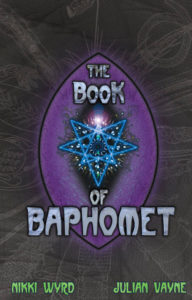
Click here for Kindle UK edition
Click here for Kindle USA edition
The Book of Baphomet
Julian Vayne & Nikki Wyrd
Format: Hardback/232 pp.
ISBN: 978-1-906958-46-6
£25.00 / US$3400
Subjects: Chaos Magick
–
You hold in your hands the material result of many years’ hard craft.
This Book contains some of the secrets of Life itself; or rather, the
occult deity of Life on Earth, Baphomet. Horned, vital, beautiful, awful, our aeons old Chaos Magick idol finds a name from the Knights Templar, then goes incognito through the Enlightenment (when flourished those great natural philosophers beloved of science historians), before emerging via devil worship and witchcraft into this era of Deep Ecology.
Darwin could have used a picture of Baphomet as his frontispiece, to
demonstrate the one flesh from which all species originate. Contacting
this Great Spirit, the anima mundi, allows access to a new way of
ordering the world, with fresh visions of how and why we could Live.
Here the authors weave strands from their lives into a rich tapestry
of images, which might give you a pointer or two towards your own
self-realisation, whilst amusing, entertaining, and instructing along
the way.
Revolution, evolution, leap beyond the apocalypse to the Now!
—
“An excellent read, consisting as it does of such a wealth of information, research, anecdote, experience and vision” – Peter J. Carroll
“It is a very fine book, in which your two voices form a harmonious whole, and which manages to interweave cosmology, history, science, autobiography and drugs in a very effective way which probably nobody else could have managed.” – Prof. Ronald Hutton
“I have finished the book and found nothing I would object to. It is most excellent. The so-called Occult world is full of really bad books that are a sad waste of trees. Yours shines amongst this dross.” – Ian Read
“Altered state of consciousness just reading it…”- Alistair Livingston
“A fascinating, poetic revisioning of the concept of deity for the 21st century”
– Levannah Morgan
Watch The Book Of Baphomet (Trailer)
vimeo.com/41602409
Check out
The Blog of Baphomet, a magickal dialogue between nature and culture.
theblogofbaphomet.com
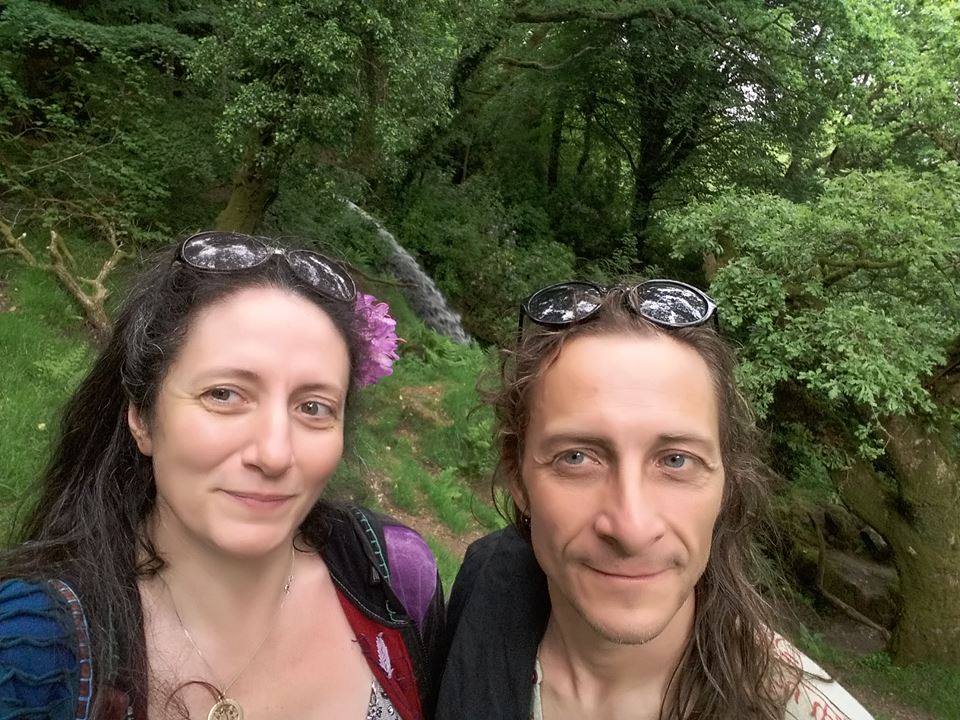
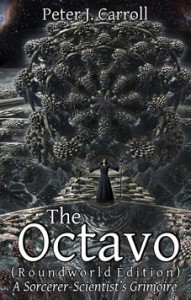
The Octavo
A Sorcerer-Scientist’s Grimoire
Peter J. Carroll
Format: Softcover
ISBN: 9781906958176
£15.00 / US$24.00
Subjects: Chaos Magick
Click HERE for The Octavo / USA
Click HERE for The Octavo / UK
Click here for Kindle UK Edition
Click here for Kindle USA Edition
Every universe potentially has its own Supreme Grimoire containing the spells which define its reality and the magic which you can perform within that reality. In this Octavo we have assembled scattered secrets for a Supreme Grimoire for Roundworld, the universe in which you’re standing.
To this end we have taken some inspiration from Pratchett’s Discworld, and a lot from Theoretical Physics and Practical Chaos Magic.
The most original, and probably the most important, writer on Magick since Aleister Crowley.”
– Robert Anton Wilson. Author of the Cosmic Trigger trilogy.
Review of The Octavo by Dave Lee
This is the second book Pete Carroll has brought out in the last two years, after a number of years’ silence. In 2008, there was ‘The Apophenion’, which was something of a departure towards an overall philosophical position, which we might call chaoism, as distinct from chaos magic. Now he presents us with a new synthesis that aims at a much closer marriage of scientific theory and magic than he, or, to my knowledge, anyone else, has attempted.
The first thing you’ll notice about this book (other than the excellent illustrations) is the subtitle. The reference will be lost on non-Pratchett experts like me; I’ve enjoyed a few of Pratchett’s books and found others a bit twee for my taste. (I have to admit, though, that he shows superb understanding of the thermodynamics of godhood in ‘Small Gods’, and a brilliant vision of the Other in ‘Lords and Ladies.’) Apparently, there’s an Octavo of Discworld spells, and it seems this volume is using the conceit that it’s the Roundworld equivalent in order to show how physics and magic can be combined in two very different universes.
The second thing you’ll notice is the physics. Publishers say that every equation in a book halves the readership, and there are a lot of them in The Octavo*. More, in fact, than in Liber Kaos, but they – at least the ones in the first few chapters – are of a very different kind.
The ‘Equations of Magic’ in Liber Kaos have always been problematic: they dealt in quantities which are not measurable, and probably never will be, like ‘degree of gnosis’ and ‘magical link’. So, they are not really equations, but things that look like equations; what they amount to, at best, is a mental checklist, a summary of what we know about magic so far. With a shorthand like that, all that matters is that it’s easily memorable, and the physico-mathematical symbolism does not help at all.
The equations in Octavo are very different. They are much more ambitious, genuinely cosmogonic in nature, and I suspect they have some very important things to say – to those who understand them rather more deeply than I do. I did get lost for much of chapters 2 and 3 (I only have maths to just short of A-level), but surfaced again at the start of Ch 4, where he compares Discworld and Roundworld physics, and comes out with some pretty profound stuff.
One of the things that’s particularly interesting about Carroll’s science is the way he attributes real physical – or aetheric / shadow-physical – reality to quantities that appear in the fundamental equations of physics. In Liber Kaos for instance the wavefunction in the Schroedinger equation is a measure of a real quantity in shadow-time, rather than a mere mathematical convenience, to be discarded as soon as possible in the course of calculations. No, Carroll finds a home for these misty, despised quantities, integrating them into a description of a magical universe. In The Octavo, he comments about quantum superposition, which is a concept we’re normally just supposed to get our heads round, that it actually has fine detail which makes it much more physically real – the alternative forms of the particle are kind of parked in sideways-time. For me, that is a distinct improvement on the usual way superposition is described.
This realistic use of mathematical entities recalls Galen Strawson’s ‘real materialism’**, as does this (p97):
‘A visualized or imagined event can have a similar effect on the imaginary time plane as the probability function of a material event, because it too constitutes a wave-particle event’.
In other words, ‘thoughts are as real as rocks’, to the real, Strawsonian materialist. Carroll also gives a physico-mathematical reality to Sheldrake’s morphogenetic fields – they are the information contained in the virtual radiations emitted by everything all the time.
I do like the depiction of particles as closed universes (p23), and it’s satisfying to read Theories of Everything, but the problem for the mathematically sub-literate becomes: how can I distinguish the true ones? I’m not sure that Carroll’s doing away with the Big Bang (a dirty job, but someone had to do it) yields a truly more complete ToE than the current one: a steady state model of the universe comes no closer to explaining where everything comes from than the expanding-from-a-point one does, it simply makes it an unaskable question, which is not the same thing. His cosmological explanation of the red shift (the core mystery of cosmology) involves something like a new mechanism for Zwicky’s previously-rejected ‘tired light’ hypothesis, and I have asked a mathematical friend of mine how viable an explanation it is.
Some of my reservations about this book stem from Carroll’s over-willingness to form Laws. Right near the beginning of the book, he has concreted the ‘multiple selves’ model into one. The idea of selfhood as multiple arose out of a very postmodern milieu of thought about what we are, and has proved very useful to magicians. However, it does suffer from a vagueness at its core: it would be a good idea to clarify the difference between personalities and the moment-to-moment sense of selfhood. The former may be usefully thought of as multiple, but the sense of self is always and ever phenomenologically singular. I challenge anyone to describe how it can be sensed otherwise.
This excessive taste for laws surfaces again on p66, where Carroll attempts to prove that there is always ‘ an even number of selves’, with an argument I found so unconvincing I suspect the author is self-consciously preaching to the choir, knowing we’ll indulge him.
My main criticism of the book is that the ‘Equations of Magic’ reappear in Ch6. I’ve said above why they are not equations, but simply tally-sticks; they remind me of Frazer’s useless laws of magic, but with added algebra to put more people off. Has a magician ever told you they’ve helped him or her plan a working?
Their inclusion wouldn’t be such a bad thing if it wasn’t for the very high quality of arguments pursued using real equations in the cosmological parts of the book: to someone who hasn’t been following the maths very closely but can see how the EoMs cannot be real equations, they simply serve to cheapen the value of the other equations and arouse suspicion about their validity. And to use them to derive, via a complicated chain of reasoning, the conclusion that group magic is no more powerful than individual magic is pure tautology, because the only way anyone could get that conclusion would be by building it into the ‘Equation’ in question.
By the way, can we have a straw poll on this? My feeling is that group magic is immensely more effective for some kinds of enchantment.
The final complaint I have is a purely aesthetic one. Sure, it wouldn’t be a bad idea to replace the phrase ‘material base’ with something else, because we do talk about servitors quite a lot. But the term ‘groundsleve’, to my ear, is down in the flooded and odious basement of English, along with ‘staycation’ and ‘bromance’. (OK, I suppose that means I’ll have to come up with one myself.)
Back to a few final words of praise: One of the satisfying things about this book is the way Carroll fills out and brings up to date old ideas, some of which he has developed and used years before. Like the way the good old GPR gets completed into the GCR, a much more symbolically satisfying and complete thing.
Proper weight is given to the Apocalypse, and what wizards can do to help avert the collapse our stupidity has got us into.
I have to make a special mention of the llustrations. If there was an award for ‘best occult book graphics of the year’, then Matt Kaybrin’s would sweep it, with these bold, dark, unusual mixtures of traditional and cyber-art.
In the end, I would definitely recommend this book. It is important, maybe very important, and will stir some interesting thoughts even in the non-mathematically-inclined. Carroll’s basic attitude to mysteries is the only healthy one: not to try and banish them, like the Dawkinsian parascience bunch, or use them to obfuscate, like the religious do. He writes: ‘Mysteries should present challenges, not opportunities for dumb belief.’
*I showed the book to a mentally tough shaman I know, and as soon as he saw the equations, he declared he’d rather chew his leg off than try to understand them.
‘The Octavo is remarkable in the finest sense of the word: a great and indeed unique achievement, making a genuine physics of magic’.
– Professor Ronald Hutton

Aromatic Oils
A guide to their use in Magick, Healing & Perfumery
Ray Sherwin
Format: Softcover
ISBN: 978-1906958039
£15.00 / US$22.00
Click HERE for Aromatic Oils & Magick / UK
Click HERE for Aromatic Oils & Magick / USA
Click here for Kindle UK edition
Click here for Kindle USA edition
Discover the Magick of Aromatic Oils 🌿✨ Dive into Ray Sherwin’s unique guide on using aromatic oils for magick, healing, and perfumery! As a renowned chaos mage, Sherwin brings an enchanting blend of wisdom, covering everything from essential oils and therapeutic uses to creating your own perfumes. Plus, enjoy fascinating stories, occult poetry, and insights into the mystical world of scent—from Patchouli and pheromones to witch doctors and ghostly tales.
Awaken your senses and explore the magick within each drop!

Click Here for CHAOTOPIA! / UK
Click here for Kindle UK edition
Click Here for CHAOTOPIA! / USA
Click here for Kindle USA edition
Chaotopia!
Dave Lee
Format: Softcover
ISBN:
£15.00 / US$26
Subjects: Chaos Magick
–
‘Once one is fairly competent at practical sorcery, there is little of importance that remains to be said or read about the subject; the magician at this point tends to emphasize inner development in his work. It seems to me that Chaos Magic itself has reached this point; the basic ideas needed for anyone to construct his or her own system of sorcery and to hone their skills are already covered by the available books. What has been lacking so far, is a Chaos magical approach to the investigation of the ecstatic states that underlie magical gnosis. This book, rather than trying to provide yet another slightly different flavour of Chaos technique, takes as its starting point the relationship between ecstasy and magic; between Chaos Magic and Chaos Mysticism, if you like.’ from Chaotopia! page 8
Chaotopia! is neither Utopia nor its opposite. It is what Austin Osman Spare called ‘the chaos of the normal’, seen through an illuminated eye, the eye of the sorcerer.
Chaotopia! includes updates and evaluations of techniques in Chaos Magick and an exploration of ecstatic states in relation to both magick and mysticism.
Also chapters on:
Wealth Magick/Conflict and Exorcism/Sex Magick/Body Alchemy and Healing/Magick and Physics/Chaos Illumination/Spirits/Aeonics
Praise for Dave Lee’s Chaotopia!
‘A highly intelligent book by a leading Chaos Magician which will broaden and deepen Chaoist debate, theory and practice.’
– Peter J. Carroll
MORE REVIEWS
”Chaos magic has come magician and NLP maven Lee. This is not a primer or grimoire; instead, the book puts chaos magic in its conceptual context, explaining the theoretical and metaphysical vistas which have underscored the art’s development since its inception under the asgis of the late, great Austin Osman Spare.
It allows us to see chaos magic äs a form of autonomous mysticism; not so much a syncretic exercise in cosmic tourism äs a balancing attempt to make sense of what arrives in one’s head. This makes it more democratic than the intimidating acolytism of learned magic in the European tradition. Chaos magic rests on the principle that the practitioner can apply belief at will, rather than surrendering to any particular paradigm (thus the slightly wrenched meaning of ‘paradigm stuft’ in chaos practice). It also assumes that altered states permit a powerfui interaction with one’s own centres of power, and äs a result, chaos magicians experiment with psychotropic techniques, including drug use, meditation, hyperventilation and extreme exercise.
Lee shows us the intellectual underpinnings of a practical System, without rendering the art, or his discourse on it, abstract or arch. He sets out the theoretical contribution of Robert Anton Wilson et al, explains Aeonics, and the trajectory of its distillation from the baroque theatre of angelology, and expounds the vital notions of chaos and Illumination, äs Spare originally conceived them, and as practice has altered and matured them.
This is not for the beginner in chaos magic, but it is a good guide for the observer with a grounding in the history of European magic, and a grasp of its cultural milestones. If you ever wondered why magicians do what they do, it’s because it works. If it didn’t, the tradition would have died out with the birth of science; it hasn’t and is enjoying a fertile period. Chaos magic is central to the continuing health of magical traditions, and writers like Dave Lee are central to that influence. His observation that accomplishe magicians concentrate on inner development ties chaos magic firmly to the Spiritual traditions of alchemy, and suggests that the development of chaos magic as a Spiritual endeavour has a long future, as well äs a brilliantly energetic past. Great stuff.”
Review from Sly Delaney – FT214 – Fortean Times verdict 8.
—-
”Chaos Magick has been the “sorcery” of choice for some years; indeed it is feared by many to have become way too trendy. There have been many books coming onto the market supposedly outlining the Chaos Magick vision which seem to confuse incoherence with mystification.. However, I am very pleased to say Chaotopia! is not one of them indeed I consider it one of the better books on Chaos Magick I have read in quite a long time. It was originally published in 1997 but includes a very succinct but updated introduction which gives us a snapshot of the basic principles of Chaos Magick and how it works.
In many way I found Chaotopia! a real “debate starter” it covers so many subjects, all of which demand further thought, investigation and discussion, for a relatively small tome of 200 odd pages there is little “padding” and lots of content, no wasted words here ! There are carefully placed “interludes” which include all sorts of exercises, meditations and rites in addition to practices throughout the work so Chaotopia offers a solid balance of theory and practice.
Lee outlines a theory of magick based on Leary and Robert Anton Wilson’s model of Eight Brain Circuits; this is quite an intriguing model and does offer quite a lot of insight into how magick work. He also outlines later in Chaotopia! Carroll’s model of Aeonics and cultural evolution. For the budding Chaos magician I would suggest comparing these with such developments as Spiral Dynamics and Ken Wilber’s Integral Model, each has its benefits and drawbacks. The Eight Brain Circuits are more practical (i.e. psychedelic), while Wilber’s model is certainly more cerebral. Aeonics has a magical foundation but I think lacks some integration into the bigger picture which Wilber’s offer. As you can see there is a lot to think about in this work ! Every chapter I read made me what to read more, think more and practice more….
There is a very insightful chapter on wealth and money, a subject looked down on by “high” magick and yet so imperative in today’s busy and demanding work. There is a great section on cursing and exorcism which avoids the paranoid mood so often found in works on “psychic self defense” and offers down to earth guidelines and well as techniques if you really need them.
The section on sex and magick is impressively without pretense and covers all sorts of issues ranging from the use of sexual fluids to S & M. I especially found the section on sex and smell impressive and felt Lee explored area’s ignored by other works.
The theoretical chapter on Magick and physics is a real intellectual stimulator. It offers a new theoretical foundation for magick as found within the Bose-Einstein Condensate. It will trigger lots of discussion and debate.
I could continue chapter in this way. There is so much packed in here. Chaotopia! is how magical books should be written. No padding, no BS, no wasted space, lots of important information, practice advise and hints. An avoidance of pretense and an openness which leaves the reader eager to go out and learn more and practice more.
Dave Lee, Thank You !”
Review in Living Traditions
—–
You enjoyed reading Bright from the Well and Chaotopia! and would like to know more about the latest techniques, articles, resources, workshops, news and events from the author, then check out DAVE LEE’S CHAOTOPIA WEBSITE www.chaotopia.com
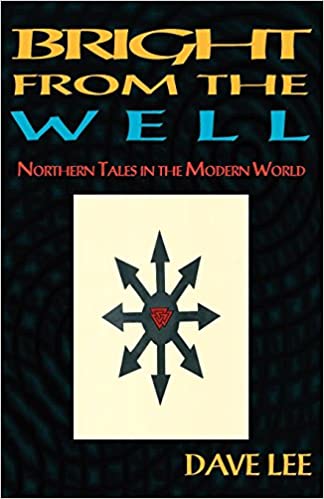
Bright from The Well
Northern Tales in The Modern World
Dave Lee
Format: Softcover
ISBN: 978-1869928841
£15.00/ US$22.00
Subjects: Northern Tradition/Chaos Magick.
Click Here for Bright from The Well / USA
Click Here for Bright from The Well / UK
REVIEWS
Attentive readers might have noticed me banging on about the collective & individual fading of memory, & the need to imagine an alternative language to talk about radical social change, entailing a re-memberance, or putting together of scattered parts strewn over a landscape of fragments.
Into my hands recently came a new book by Dave Lee, Bright from the Well – Northern Tales in the Modern World. Mandrake of Oxford (2008). It’s a retelling & reimagining of the creation & social origin myths of the Northern European tradition, including the Völuspá, & Rigsþula (Rig’s Tale). Comprising five short stories & five essays, it’s an odd but compelling read, combining a reworked & updated phenomenology of the myths with vividly told stories set in the contemporary world of would-be sorcerers & Chaos Magic.
Those with a suspicious turn of mind wrongly might detect a whiff of the Thule Society, & the romantic/reactionary projects dreamed up by the likes of W. B. Yeats & D. H. Lawrence, which often resulted in psychosomatic afflictions of the right arm. But Dave Lee is no New Ager, sharing my view that these are people with too many easily acquired beliefs to spend, who couldn’t think their way out of a paper bag. Think rather of the imaginative legacy & radical engagement of William Blake. Great stuff, ideas sparking off in all directions.
Klaus Bubblehammer, Bubblehammerblog
bubblehammerblog.blogspot.com/2008/11/recommended-reading.html
–
Bright From The Well
– Northern Tales in the Modern World
by Dave Lee
Review by Akashanath
A common difficulty for magicians moving from one tradition to another is reductio ad nauseum. With little effort, it is easy to nail the symbolism of one’s latest trip onto the pre-existing crucifix of one’s earlier experiences, eventually reducing every opportunity for novelty to a stale repeat of one’s preconceptions. Chaos Magick has often fallen into this trap, its dogma of ‘non-dogmatism’ leading adherents to strip belief-systems to their ‘essentials’, sometimes to the point where they lose much of their beauty and function. At the opposite extreme one can simply be overwhelmed by the strangeness and unfamiliarity of a new world-view, and fail to find a point from which to begin one’s assimilation. The Norse and Saxon myths, with their fragmented, archaic language and almost prehistoric themes, can often evoke this type of response. In his newest book, Dave Lee lithely navigates the pass between these twin peaks, taking time to pause and explore the dilemmas, or muse on them in the form of short fables. People expecting a book about the runes will not be disappointed. Those hoping for further expositions on the subject(s) of Chaos Magick will find plenty of interest. But for me where Bright From The Well comes into its own is as a series of reflections on dilemmas that will be familiar to many 21st century occultists.
For example, Chapter 5 is entitled “The Magician In and Against The World.” It’s essentially an analysis of the twin functions of the magician as anarchist, challenging the false autocracy of consensus reality, and the magician as priest, strengthening social traditions by helping the laity to connect them to their spiritual and cosmic sources. Within his complex analysis, Dave grapples with magicians’ tendencies towards transcendence on the one hand and immanence on the other. This rang loud bells for me; in my magickal quest I have often lurched from mind-bending hedonism to ruthless ascetic austerity and back again, struggling to marry my hungers and drives with some arbitrary construct of ultimate purpose. Dave also concludes that some sort of unification is necessary, describing this in terms of the intermarriage of the Vanir and the Aesir, the two Northern pantheons who exchange hostages somewhere near the beginning of time. Dave’s exegesis interprets the former as gods of immanence and the latter as deities of transcendence and consciousness (though not exclusively so). In a story from Snorri’s Prose Edda, Dave tells us how the Aesir (in the form of Odin) and the Vanir (in the form of Tyr) trick the Fenriswoolf (primal chaos) into allowing itself to be bound, creating the ordered universe that is a necessary precondition for human society and hence both esoteric and exoteric religious practice.
Students of Tantrika may find parallels here, and indeed Dave makes passing reference to the left and right hand paths. In many contemporary Hindu icons the transcendent Shiva is depicted sitting on his mountain, meditating and smoking Ganja, largely disinterested in the world. One myth tells us how the goddess Kali once went on a killing spree. Initially invoked by men seeking support in their war with the demons, Kali has lost sight of her original intention in an orgy of destruction. With all the demons slain, she turns her unstoppable fury on her former allies, slaughtering them with her many arms. Summoned from his mountain, Shiva is intrigued. Lying in front of her with his c**k erect, he looks up, turned on by her warped face and blood-stained body. Gradually her lust for killing turns into a different kind of lust, and the two deities begin to f**k. Separate from one another, they are aimless, functionless. In unity, Siva (transcendence) gains the capacity to manifest in the physical world, while Kali (immanence) transmutes her destructive power to generative.
Some of the other sections completely obviate the need for parallels by speaking directly to the magician’s experience. In Chapter 7, the author recounts a fascinating and credible list of magickal anecdotes spanning over 20 (and perhaps closer to 30?) years of workings, grouped into a rough typology of function. Several chapters take the form of stories, some obviously derived from Nordic originals, others less so. The style is engaging and entertaining, not laboriously educational or annoyingly whimsical, and each is short enough to be knocked off quickly (or omitted altogether) should it not be to the reader’s taste.
As well as re-telling stories from the northern traditions and presenting a novel method of working with the entities described as dwarves, the book contains a complete rune poem in English. Although it probably wouldn’t stand alone as a manual of rune magick, anyone genuinely interested in the subject could probably learn something new. The main strength, for those interested in Nordic traditions, will probably be for those looking for another perspective from which to triangulate dry, historical academic texts on the one hand and the often pedantic dogmatism of modern Odinists on the other. Overall, as the title implies, the collection is refreshing and inspired. Well worth a read!
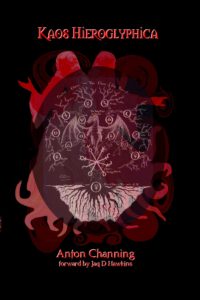
Kaos Hieroglyphica
Anton Channing
Format: Hardback Case Laminated.
ISBN:
£19.99/US$35
Subjects: Chaos Magick
–
‘Mr Channing plays Trotsky to my Lenin, and Luther to the most holy of Chaos Orthodoxies.’ – Pete Carroll
In the year 1564, Dr John Dee published his work, Monas Hieroglyphica. Its central symbol represented the unity which was the gnosis of the monotheistic aeon.
Now over four hundred years later, Anton Channing has published his long awaited debut work Kaos Hieroglyphica, within which he expounds a new symbol, the Kaos Hieroglyph. This symbol represents the plurality and freedom of the New Aeon. This work of magical alchemy draws on such diverse material as Thelema, the Chaos Current, the Maat Current, Timothy Leary, Witchcraft, Paganism, the Hermetic Tradition, Taoism, Shamanism and the author’s own Pineal Gland.
The Kaos Hieroglyphica offers the reader interpretations of Hermetic symbolism in a way that is both insightful and relevant to New Aeon Magic.
Contents
Forward by Jaq D Hawkins
0. Introduction
1. The Cybermorphic Kaosphere System
2. Pure Magick
3. Duality
4. Elemental Magick
5. The Eight Colours of Magick
6. The Kaos Hieroglyph
Appendix A – Aeonics
Appendix B – Eight Circuit Model
Appendix C – Training Programme
Appendix D – Divination
Appendix E – Kaobala
Peter J Carroll. December ’04:
Infamy! Infamy! Anton has surely got it in for me, in these two hundred pages of relentless revisionism. Here we see heresy of the most outrageous kind, Mr Channing plays Trotsky to my Lenin, and Luther to the most holy of Chaos Orthodoxies.
Methinks I may excommunicate him with extreme prejudice for revealing the secret asymmetries and imbalances in my Eight Magics which have propelled me to global notoriety, undeserved riches, and domination of the metaphysical realms.
May Baphomet dam his loins and may Eris make his balls explode, for he hath proposed a counter-reformation back into the antique concepts of soul, ‘being’, and symbo-realism.
He even proposes, and mark this, an alternative order completely lacking even the most basic dominance hierarchy, terrible secrets, and bloodcurdling initiation rites, yet he seems such a reasonable guy.
I have arranged to have a drink with him to see where it all went new-age shaped.
In the meantime read the book, I found it both provocative and entertaining but I have to warn you about the shockingly high ‘is’ count. That in itself provides a key to the symbolistic conceptual style of the author.
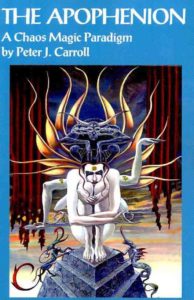
The Apophenion
A Chaos Magic Paradigm
Peter J. Carroll
ISBN: 978-1869928650
Format: Softcover
£15.00 / US$24
Subjects: Chaos Magic
Click HERE for The Apophenion / USA
Click HERE The Apophenion / UK
Click here for Kindle UK Edition
Click here for Kindle USA Edition
From the Author
“My final Magnum Opus if its ideas remain unfalsified within my lifetime, otherwise its back to the drawing board.
Yet I’ve tried to keep it as short and simple as possible, it consists of eight fairly brief and terse chapters and five appendices. It attacks most of the great questions of being, free will, consciousness, meaning, the nature of mind, and humanity’s place in the cosmos, from a magical perspective.
Some of the conclusions seem to challenge many of the deeply held assumptions that our culture has taught us, so brace yourself for the paradigm crash and look for the jewels revealed in the wreckage.This book contains something to offend everyone; enough science to upset the magicians, enough magic to upset the scientists, and enough blasphemy to upset most trancendentalists.”
The Apophenion cover artwork by David Gough www.davidgoughart.com
”Apophenia is the experience of seeing meaningful patterns or connections in random or meaningless data. The term was coined in 1958 by Klaus Conrad,[1] who defined it as the “unmotivated seeing of connections” accompanied by a “specific experience of an abnormal meaningfulness”. Source Wikipedia
Praise for Peter J. Carroll’s works
“The most original, and probably the most important, writer on Magick since Aleister Crowley.” Robert Anton Wilson, author of the Cosmic Trigger trilogy.
“Magicians feared they had lost Him to the world of Theoretical Physics, but Zarathustra has come down from the mountain. The Apophenion is spoken – and proves the wait was worth it. Religion starts the hunt for Meaning, and with science Meaning is killed and served up as Truth. So we need magic, sowing the seeds of Meaning in everyday events, and we need art to cultivate them to public awareness. Thus does Apopheniareveal how to bring back meaning to our diminished lives.” Lionel Snell, Aka Ramsey Dukes, author of SSOTBME.
REVIEWS
THE APOPHENION
by Peter J. Carroll
‘Framed as the outpouring of insight generated by the novel Goddess ‘Apophenia’, Pete Carroll’s new work is a real gem. Coming from a science background, this is his attempt to create a falisfiable model of why the universe looks the way it does, and just why magick can operate successfully.
In the inimitable Carrollian style we have come to know and love, our author sets out to demolish the edifices of being, consciousness, causality, the big-bang and more. In toppling these ontological Titans Pete discovers a universe of panpsychism and intense meaning.
If nothing else this agrees with my own views and is therefore a Good Thing. Pursuing this process through the scientific style of exploration means that quantum physics, special relativity et al show up pretty frequently in the text. If you buy this book expecting lists of planetary correspondence and ritual-by-numbers instructions you’re going to be disappointed.
However this doesn’t mean that this is all physics and no esoterica. Rather the point is that the reading of the universe that the author presents is suffused with magick. (Nevertheless there are some reassuring illustrations of occult entities and one explicit ritual – a rather lovely evocation of the Goddess Apophenia herself).
My reaction in reading this book was one of excitement. The suggestions that Pete advances tickle the mind delightfully. Certainly this isn’t Liber Null. It’s not a manual of techniques but instead concentrates on theory, yet that doesn’t make for a dull read. The theorisation presented here can light the touch paper of a hundred disciplines: cosmology and magick for sure but also Fortean studies, ethnography and especially neuro-biology.
Algebra explodes across the appendices of the book scattering the non-mathematicians towards the Epilogue where things are nicely rounded off in laypersons terms. The truth may well be that we live in vorticitating hypersphere with three dimensional time that, as the author beautifully asserts, “…invites us to become apprentice gods.” The very fact that I can now say ‘vorticitating hypersphere’ and know what that means is a testament to the authors explicatory powers.
The final and perhaps most wonderful thing about The Apophenion is how it demonstrates the development and maturation of Pete Carroll’s earlier writing. If nothing else this stands as a testament to the work of an individual (or perhaps conspiracy of selves!) who’s magick really does seem to work.
Eight chaospheres out of a possible eight!’
– Julian Vayne